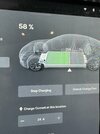First of all Tessie is wrong.
In the meter it should say 85.8 kWh, as per reference to the people with knowledge to Model S (I’m so far only a model 3 guy, at least for the next few days…

)
You can change that by thapping and altering the number.
Tessie calculates the number by added km range after charging. The reported number for charges includes the portion of the buffer, wich never was charged into the battery (as the buffer was already there).
Teslafi shows estimated range at 100% and also the average from other similar cars.
You do not get a capacity number or a degradation number. (You get relative numbers between current, highest and lowest range numbers though).
Teslafi, like Tessie get the over-the-air-data which has some limitations.
Teslafis number for calculating the range is rounded SOC to the whole percentage, but the reported range is with two digits.
This means the reported range jumps up and down by 5 km or so despite the nominal full value and the true range is beeing same.
Also, I always did get more range on a real full charge than the current graph shows.
Last full charhe showed 492 km but teslafi hovers around 487-490.
View attachment 950046



